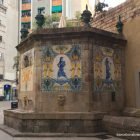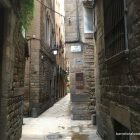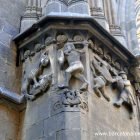With over two thousand years of history, Barcelona’s Gothic Quarter is a labyrinth of narrow streets and striking Gothic architecture that dates back to the Middle Ages and the times of the Roman Empire.
Located between Plaça de Catalunya and the Port Vell Harbour, the Gothic Quarter is the heart of the Old City and is where you will find many of Barcelona’s most historic sights, as well as the City Hall and other civic buildings.
Many of the narrow lanes and alleyways are only accessible on foot, and the Barri Gotic, as it’s called in Catalan, is a perfect area for exploring and wandering at your own pace. The itinerary outlined below visits the Gothic Quarter’s most interesting sights and guides you through some of the most picturesque streets and plazas.
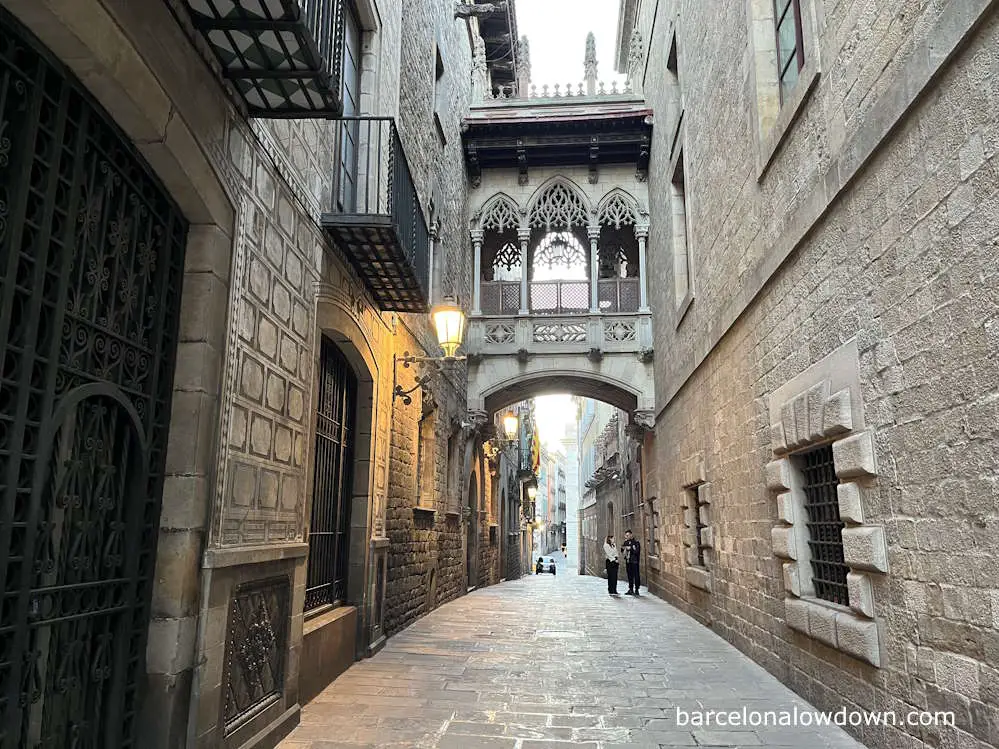
The route is just under five kilometres long and, if you decide to walk it non-stop, would take approximately ninety minutes. However, I recommend taking your time and going inside at least a few of the buildings and museums, turning the route into a perfect half-day itinerary.
As usual, I’ve created a Wikiloc trail, which you can download to your phone. However, GPS coverage is quite poor in the narrow streets and alleyways, so I recommend keeping a copy of the instructions below for reference.
Don’t worry if you go astray. The Gothic Quarter is quite small; if you keep walking, you’ll soon find somewhere you recognize. If you aren’t comfortable with the idea and think you might get lost, I recommend this Gothic Quarter Walking Tour, which visits many of the sights mentioned in this post.
A Brief History of the Gothic Quarter
Barcelona was first settled around four thousand years ago in the Neolithic period. The city as we know it today evolved from a Roman settlement called Barcino, which was founded in the first century BC and formed the nucleus of what is now the Gothic Quarter, centred on Plaça de Sant Jaume.
Although less important than Tarraco, the settlement quickly grew into a prosperous Roman city, complete with a forum, bathhouses, palaces, defensive walls and a grand temple dedicated to Caesar Augustus. This map shows Barcino superimposed on a modern map of Barcelona and clearly illustrates how the streets of the Gothic Quarter correspond with the streets of the Roman city.
In 415 AD, after the decline of the Roman Empire, Barcelona was taken over by the Visigoths and remained under their rule for three centuries. The Visigoths, who controlled much of the Iberian Peninsula and part of France, converted Barcino, which they renamed Barcinona, into their capital city due to its central location and strong defensive walls.
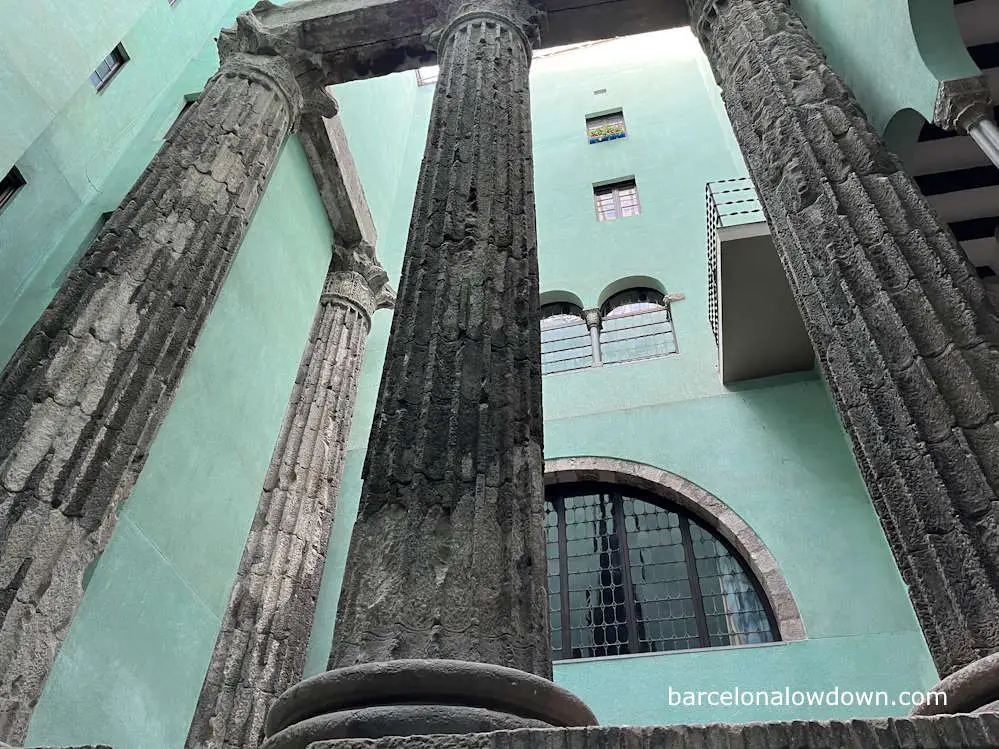
Visigoth rule ended in 755, after the Moorish invasion from the south when Barcelona came under the control of the Emirate of Cordoba. Muslim rule was relatively short-lived, and in 801, Barcelona became part of the Carolingian Empire after being taken by Louis I, son of Charles the Great.
Under Frankish rule, Barcelona became part of the Spanish March, a militarized buffer zone which separated the Moorish kingdom of Al Andalus from the Christian territories to the north. The Spanish March was divided into counties, each of which was governed by a count.
During the two centuries which followed, Barcelona repeatedly came under attack until, in 985, the city was razed to the ground. After this attack, Barcelona broke away from the crumbling Carolingian Empire. The Roman walls were further strengthened by adding three castles: Castell Nou, Castell Regomir and Castell Vell.
Today, all that remains of the castles is a small window above the storefront of the Sombrerería Obach hat shop.
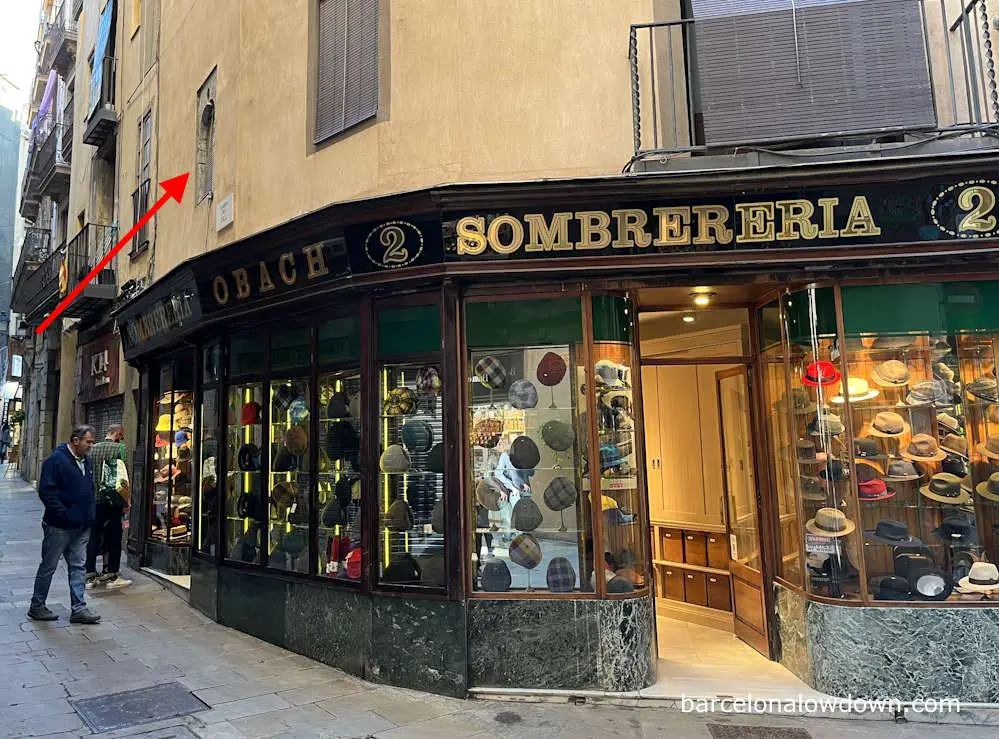
During the eleventh century, Barcelona became more powerful and began annexing neighbouring counties, including Girona, Ausona, Cerdenya and Besalú. In 1150, Ramon Berenguer IV, Count of Barcelona, married Petronila de Aragon, uniting the Kingdom of Aragon with the County of Barcelona to form the Crown of Aragon.
During the thirteenth and fourteenth centuries, the Crown of Aragon began establishing trade routes and expanding across the Mediterranean to control Valencia, Mallorca, Sicily and Sardinia. The population and wealth of Barcelona grew and the city spread outside the original Roman walls. New medieval walls were built, the first surrounding what is now the Gothic Quarter, La Ribera and El Born neighbourhoods, and the second surrounding El Raval.
You can find out more about Barcelona’s neighbourhoods in this post >>
Many of Barcelona’s most emblematic Gothic buildings were built during this period, including Barcelona Cathedral, the Royal Palace, the Saló del Tinell, the Chapel of Santa Agata, the Royal Shipyards, the Palau de La Generalitat, the Basilica de Sant Just and the Basilica de Santa Maria del Mar.
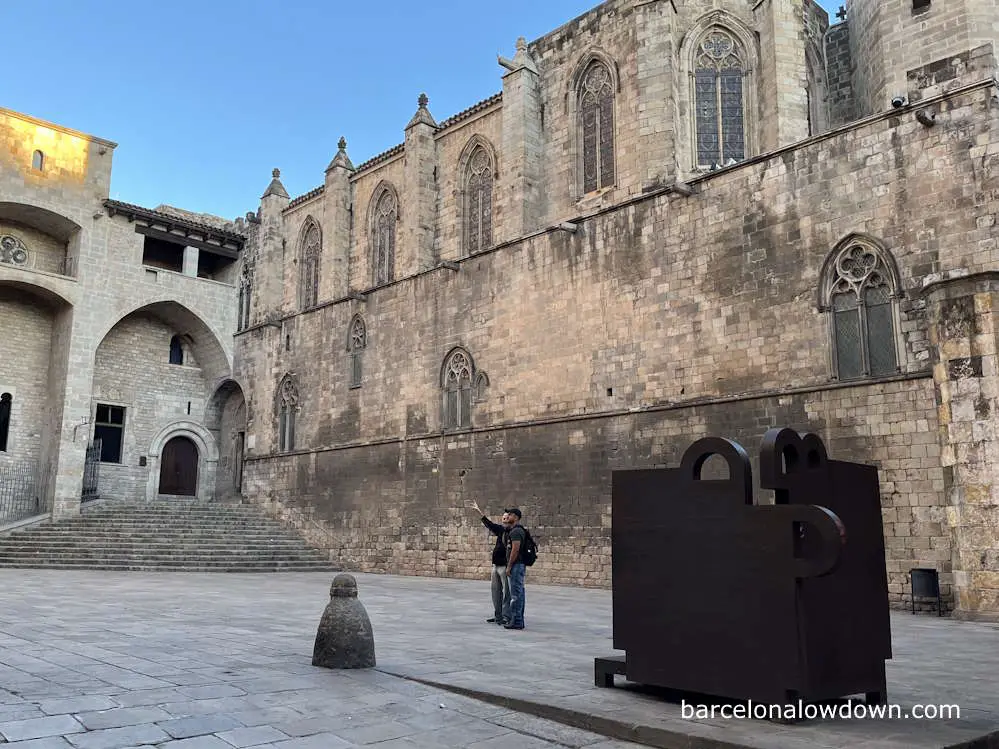
In 1469, Ferdinand II of Aragon married Isabella I of Castile, uniting the Crown of Aragon with the Kingdom of Castile.
In 1492, their combined armies finally defeated the Granada Emirate, marking the end of the Reconquista of Spain from Muslim control. The “discovery” and colonisation of the Americas reduced the importance of the Mediterranean trade routes, and the Catholic Monarchs transferred their administrative capital to Madrid.
The unification of the Spanish kingdoms and the wealth generated by their new colonies ultimately led to the War of the Spanish Succession when the Catalans sided with the Austrian Habsburgs against Philip V. The war ended in 1714 and resulted in the implantation of Nueva Planta decrees, the loss of Catalan autonomy, and the razing of part of the La Ribera neighbourhood to make way for a large Citadel, which was built to subjugate Barcelona.
During the nineteenth century, thanks to the Industrial Revolution, Barcelona was prospering again and began to expand outside the medieval city walls. This expansion had two major impacts on the old city centre.
Firstly, the medieval walls were torn down. The old city was overcrowded, and most of the medieval buildings had been divided into tiny apartments. By tearing down the walls, city planners intended to open up the old city, making it a healthier and more pleasant place to live and, at the same time, connecting it with the newer part of the city, the so-called l’Eixample district.
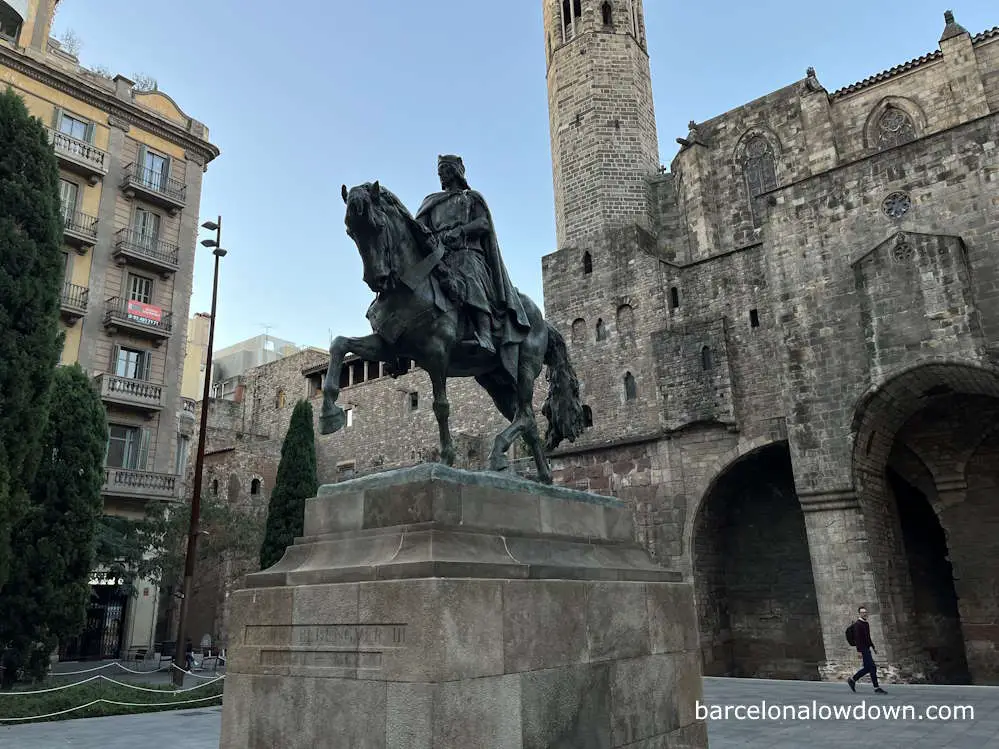
The second major transformation which took place was the construction of Via Laietana, the avenue linking the Eixample to the Port Vell, which runs directly through the middle of the old city.
The construction of Via Laitena involved tearing down a large swathe of buildings, including several emblematic Gothic edifices. Instead of destroying the historic buildings, the local authorities decided to move them and rebuild them in the neighbourhood surrounding the cathedral, which at this time was called the Cathedral Neighbourhood (Catalan: Barri del Catedral).
In the process, the area was given a facelift and many of the older buildings were restored to recapture some of the city’s medieval splendour. Some architectural features of medieval buildings which had been torn down were used to embellish existing buildings. Many of the narrower streets were closed to traffic, and the newly restored neighbourhood was renamed the Gothic Quarter.
As part of the remodelling process, Barcelona Cathedral was given an impressive new Gothic façade, and several other NeoGothic features, such as the Bishop’s Bridge, were added.

Self-guided walking tour of Barcelona’s Gothic Quarter
The tour follows a circular route which starts at the Jaume I metro stop, although you could start at any point along the way.
1. Plaça de l’Angel
Exiting the metro station, you’ll find yourself in a small square surrounded by majestic old buildings. On one side of the square, you can see Via Laietana. Running parallel to it, you’ll find the remains of the old Roman Wall, which runs alongside Carrer de la Tapinera.
To begin the tour, we walk along Baixada de la Llibreteria and take a right onto Carrer del Veguer after about 50 metres. This leads us to our first stop; Plaça del Rei.
2. Plaça del Rei & the Barcelona History Museum
As I mentioned earlier, during the Middle Ages, Barcelona was the capital of the Crown of Aragon, and Plaça del Rei was the courtyard of the Royal Palace.
The square is flanked on three sides by el Palau Reial Major, el Palau del Lloctinent and the Capilla de Santa Agata, which have been restored and converted into MUHBA Plaça del Rei, the Barcelona History Museum.
I decided to start the tour here because I think the museum is a good introduction to the history of the Gothic Quarter.
Tickets to MUHBA Plaça del Rei also include entry to the other MUHBA sites we visit later in the tour.
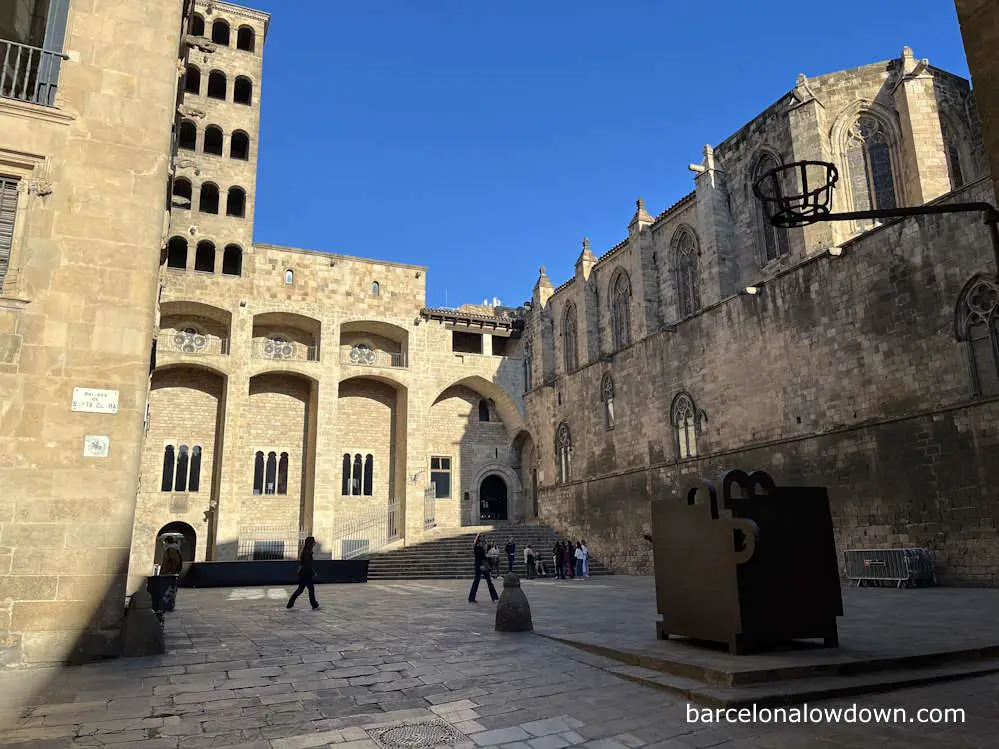
3. Temple of Augustus
After visiting the museum we continue along Baixada de Santa Clara towards the Temple of Augustus.
After a few metres, we come to Carrer de la Pietat and Barcelona’s impressive Gothic Cathedral, which dates back to the twelfth century. We’ll visit the cathedral later in the tour, so for now; we spend a few moments here looking up at the gargoyles before turning left along Carrer del Paradis.
All that remains of Barcelona’s Roman temple are four Corinthian columns hidden inside a small Gothic building belonging to the Centre Excursionista de Catalunya. A small plaque outside the building indicates that it is located on the peak of Mt Taber, which, at 16.9m high, was the highest point of the Roman city of Barcino.
There’s more information about the Temple of Augustus in this post.
After admiring the Roman columns, we continue along Carrer del Paradis to Plaça Sant Jaume.
4. Plaça de Sant Jaume
Plaça Sant Jaume has been the political centre of Barcelona since the time of the Roman Empire when it was the site of the Forum.
Barcelona City Hall and the Palau de la Generalitat de Catalunya stand on either side of the square. At the weekend, you’ll often see small groups of people with banners protesting their cause directly outside the Town Hall or parliament building.
In addition to its political importance, Plaça de Sant Jaume also hosts celebrations such as La diada, El dia de Sant Jordí, and La Mercè, to name just a few.
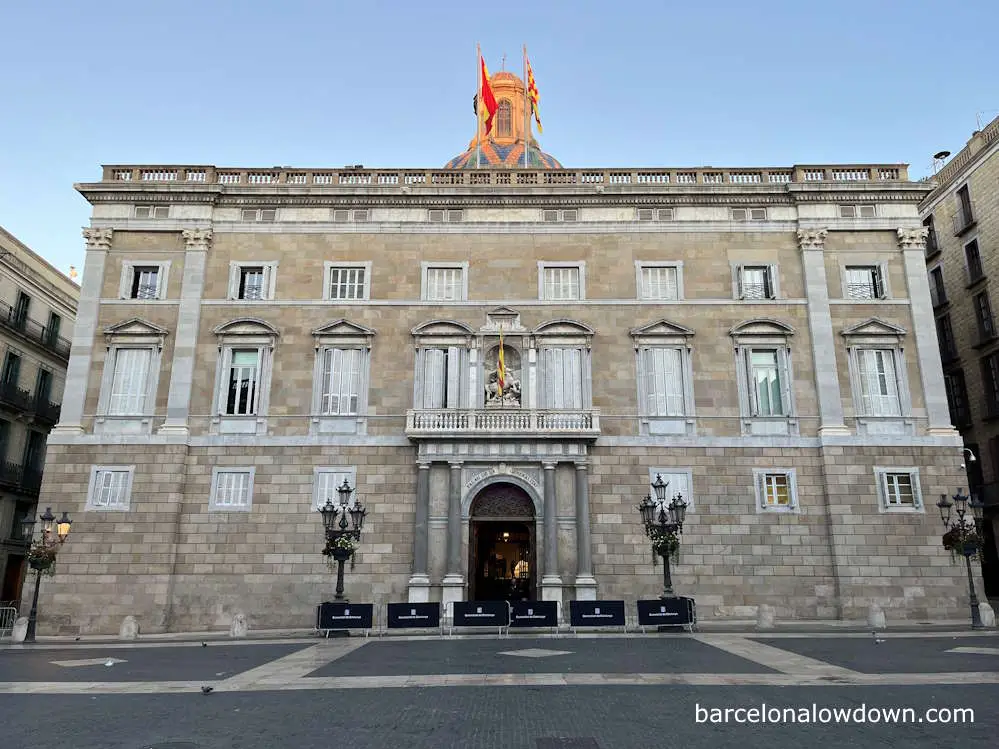
5. Palau de la Generalitat de Catalunya
The Generalitat de Catalunya is the regional government of Catalonia. Its origins can be traced back to the thirteenth-century Catalan Courts.
The Palau de la Generalitat building dates back to the fourteenth century, although the Reneisançe style main façade was built during the sixteenth century. The building’s original Gothic façade, complete with gargoyles, can still be seen along Carrer del Bisbe.
6. Barcelona City Hall
On the opposite side of Plaça de Sant Jaume stands Barcelona City Hall, a fourteenth-century Gothic building with a nineteenth-century neoclassical façade.
As with the Generalitat de Catalunya, Barcelona city council can trace its origins back to the Middle Ages and the so-called Concell de Cent, which was established during the thirteenth century.
The building opens its doors to the public each Sunday from 10:00 until 13:00 (free entry), or you can take a virtual tour here.
More information in my guide to visiting Barcelona City Hall>>
From here, we continue along Carrre de l’Arlet, which runs along the left-hand side of the city hall building. We then take the first left, along Carrer d’Hèrcules, to Plaçeta de Sant Just.

7. Basílica dels Sants Màrtirs Sant Just i Pastor
The Basilica dels Sants Màrtirs Sant Just i Pastor is one of the oldest churches in Barcelona and dates back to the fourteenth century.
The Gothic-styled church is open to the public from 10 a.m. and, although there is not much to look at from the outside, it’s worth checking out the interior and climbing the bell tower, which gives good views of the Gothic Quarter.
8. Font de Sant Just
Outside the basilica, on the other side of the small plaza, stands the Font de Sant Just, one of three medieval fountains in the Old City.
The fountain was built in 1367 when Joan Fiveller, a member of the Concell de Cent, built the infrastructure to channel water from a spring in the mountains outside Barcelona.
9. Plaça dels Traginers
Passing to the left of the fountain, we continue along Carrer del Lledo to the Baixada de Viladecols and the Plaça dels Traginers, where you’ll find another section of the Roman wall, including part of one of the original defensive towers.
From here, we turn right and follow Carrer del Correu Vell two blocks before turning left on Carrer de Regomir, which we follow until the intersection with the ironically named Carrer Ample, where we turn right. Literally translated, Carrer Ample means “wide street” in Catalan.
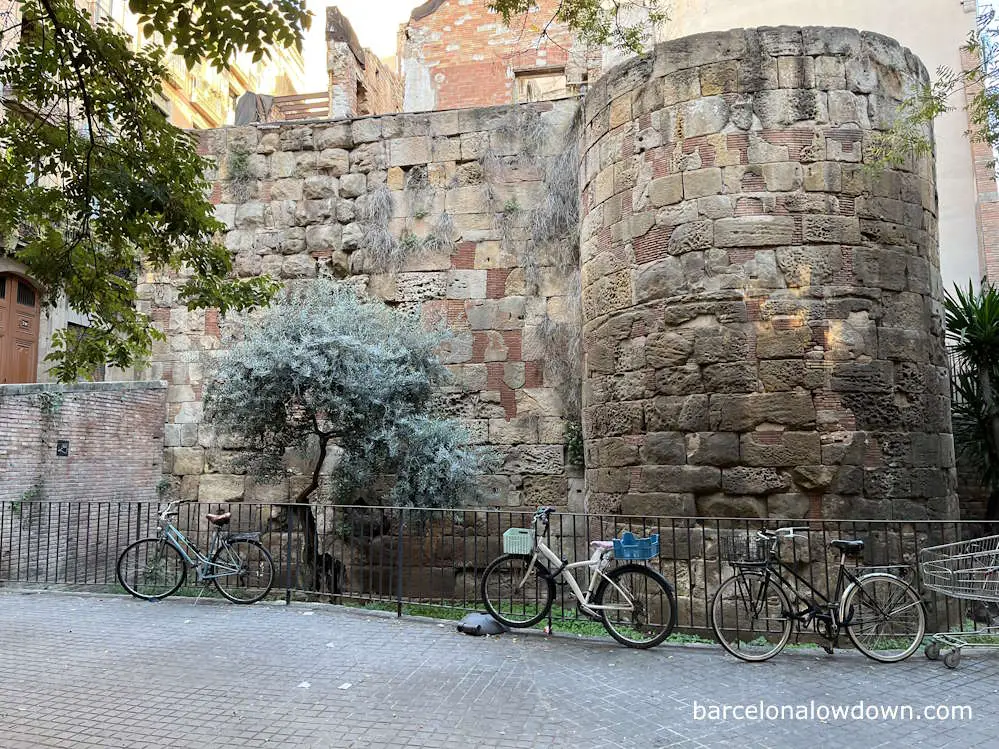
10. Hash Marihuana and Hemp Museum
At the intersection of Carre de Regomir and Carrer Ample, we find Palau Mornau, a sixteenth-century palace which currently houses the Hash Marihuana and Hemp Museum.
The museum, which is the largest of its kind anywhere in the world, explores the history of cannabis and its use in medicine, industry and popular culture. The building features an impressive Modernista interior and is well worth visiting if you have the time.
After visiting the museum, we continue southwest along Carrer Ample for two blocks until we come to the Basilica of Our Lady of Mercy.
11. Basilica of Our Lady of Mercy
The Basilica of La Mercè is an eighteenth-century Baroque-style basilica dedicated to La Mare de Déu de la Mercè, one of Barcelona’s two patron saints. The current church was built on the site of a Gothic church built in the fourteenth century.
Unlike the plain exterior, the church’s interior is elaborately decorated, and it’s worth spending a few minutes here and looking inside. The painted wooden carving of La Mercè above the altar dates back to the fourteenth century.
On the other side of the plaza, in front of the basilica, there’s a fountain with a statue of Neptune. Standing next to the fountain, you get a good view of the basilica, including the large bronze statue which crowns the dome above the altar.
There’s more information about the Basilica of Our Lady of Mercy here >>

12. Plaça de George Orwell
Next, we retrace our steps along Carrer Ample for one block to Carrer de la Carrabasa, which we follow all the way to Plaça de George Orwell.
If you fancy a break, there are several pavement cafés in the square, although, unless you see somewhere that you really like the look of, I recommend you wait a few minutes until we arrive at Plaça Reial.
Having said that, El Buen Bocado (Carrer dels Escudellers, 58) serves the best falafels in Barcelona and Vegetalia (Carrer dels Escudellers, 54) is one of the restaurants which I included in my Vegetarian’s guide to Barcelona.
13. Plaça Reial
After spending a few minutes in Plaça de George Orwell, we continue southwest along Carrer dels Escudellers for about a hundred metres before turning right into Carrer del Vidre, which leads to Plaça Reial.
Plaça Reial is an elegant Neoclassical square dating back to the nineteenth century. In the centre of the square stands a fountain called El Font de les Tres Gràcies, flanked by a pair of unusual cast iron street lamps designed by Antoni Gaudí.
The square is a hive of activity at almost any time of day and is a perfect place to stop for a coffee or a beer at one of the many pavement cafés.
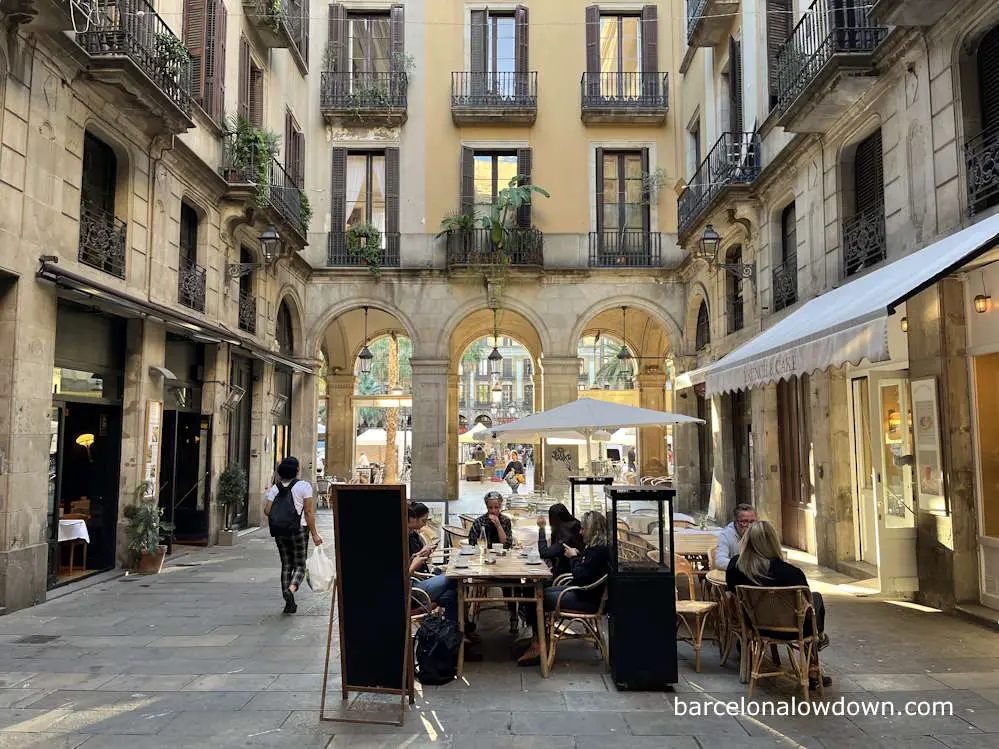
14. Església de Sant Jaume
After a short break at Plaça Reial, we continue along Passatge Madoz under the arches to Carrer de Ferran, where we turn right.
Continuing along Carrer de Ferran for about a hundred metres, we come to the Church of Saint James (Catalan: Església de Sant Jaume), which is a small fourteenth-century church that was built on the site of a synagogue which, along with many of the buildings in Barcelona’s medieval Jewish quarter, was torn down after the violent pogroms of 1391.
Although the church was built in the fourteenth century, most of the building’s Gothic façade dates back to the nineteenth century when the church was remodelled. Inside the church, there’s an impressive carved altarpiece that once belonged to Barcelona Cathedral.
After visiting the church, we continued along Carrer de Ferran to Carrer d’Avinyo, the narrow street which inspired the painting Les Demoiselles d’Avignon by Pablo Picasso. Here, we turn left and enter the narrow streets of El Call.
After a few metres, we come to an old-fashioned hat shop called Sombrerería Obach, where we turn right into Carrer del Call. As I mentioned earlier, on the first floor of the hat shop, there’s a small stone window, which is all that remains of the three castles which were built after Barcelona was attacked in 985 AD.
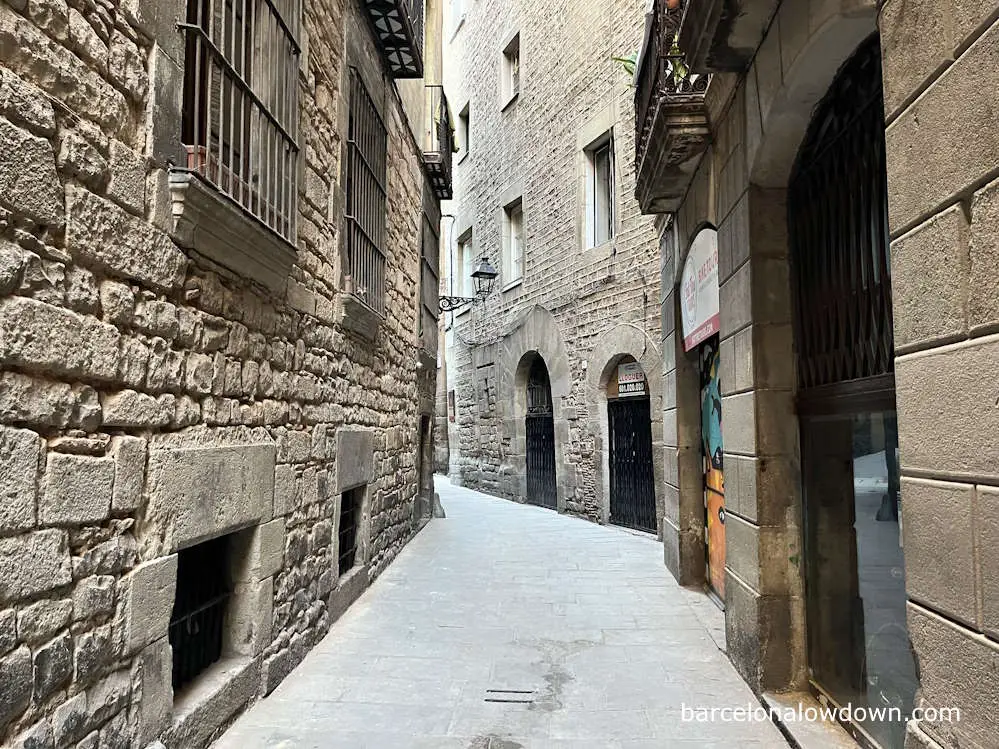
15. Shlomo Ben Adret Synagogue
After passing the hat shop, we turn left along Carrer de l’Arc de Sant Ramon del Call. A few metres later, we turn right into Carrer de Marlet, one of the narrowest streets in the Gothic Quarter.
On the left-hand side is the entrance to the Shlomo Ben Adret Synagogue, which dates back to the third or fourth century and is one of the oldest synagogues in Europe. The synagogue contains a small museum and is open to the public from Sunday to Friday.
After visiting the synagogue, we turn left along Carrer de Salomó Ben Adret. A few metres later, we come to a tiny plaza called Plaçeta de Manuel Ribé and the MUHBA El Call museum.
16. MUHBA El Call
The MUHBA El Call museum is a small museum which recounts the history of Barcelona’s Jewish community. The museum, which is housed in a historic medieval building, contains a collection of ceramics and other archaeological remains.
The museum is very small and only takes about fifteen minutes to visit. Entrance is included with the ticket to the Barcelona History Museum, which we visited earlier.
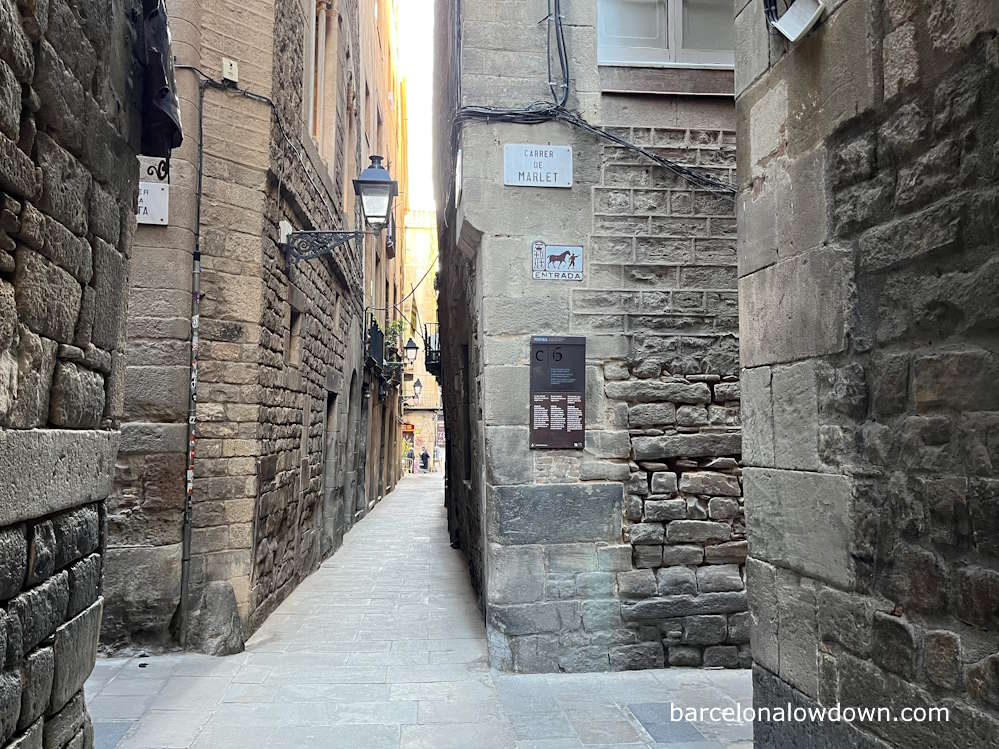
17. Plaça del Pi & Santa Maria del Pi
From the MUHBA El Call museum, we turn left and retrace our steps along Carrer de l’Arc de San Ramon del Call back to Carrer del Call, where we turn right.
After passing the hat shop, we walk two blocks along Carrer de la Boqueria before turning right onto Carrer d’Alsina. After a few metres, we come to a small plaza called la Plaçeta del Pi and the Basilica of Santa Maria del Pi, a Gothic church which dates back to the fourteenth century.
The church is flanked by three small plazas, which used to be graveyards: la Plaçeta del Pi, Plaça de Sant Josep Oriol and Plaça del Pi.
On weekends, Plaça de Sant Josep Oriol hosts a colourful artists market, where local artists set up stalls and sell their paintings. Plaça del Pi has another small open-air market selling locally produced cheese, honey and deli items.
As you walk around the basilica, you’ll notice the words Plaça del Miliciá Desconegut daubed on the walls of the church. This is the oldest piece of graffiti in Barcelona and dates from 1937. There’s more information in this post.
If you have time, it’s worth going inside the church, although much of the original interior decoration was destroyed by fire in 1936 and has been replaced. The bell tower is open to the public and affords great views of the Gothic Quarter.

18. Petrixol Street
From the Plaça del Pi, we head down Carrer de Petrixol, also known as Chocolate Street, thanks to the number of restaurants specialising in hot chocolate (Catalan: xocolata desfeta) located here. It goes without saying that this is an ideal place to take a break and enjoy a cup of hot chocolate accompanied by a plate of sugary churros.
The longest-established xocolaterias are Granja la Pallaresa (Carrer de Petrixol, 11) and Granja Dulcinea (Carrer de Petrixol, 2), both of which are very popular with the locals.
19. Roman burial ground
After satisfying our chocolate cravings, we continue along Carrer de Petrixol and turn right onto Carrer de la Portaferrissa. Almost immediately, we turn left onto Carrer d’En Bot, which leads to Plaça de la Vila de Madrid.
In the middle of the plaza is the MUHBA Via Sepulcral Romana, an ancient Roman burial ground where stone tombs were uncovered in the 1940s. A small museum here explains the site’s history and is included in the ticket for the MUHBA Plaça del Rei that we visited earlier.
20. Plaça de Josep Oriol
From here, we continue along Carrer de Francesc Pujols to Carrer del Duc where we turn left, then right onto Carrer del Pi, which takes us back to Plaça de Sant Josep Oriol, one of the three plazas beside the Basilica del Pi.
21. Baixada de Santa Eulalia
We follow Carrer de l’Ave Maria from the plaza to the intersection with Carrer dels Banys Nous, where we turn left. After turning left, we come to a narrow alley called La Baixada de Santa Eualalia.
On the right-hand side of the alleyway, just above head height, there’s a small shrine dedicated to Santa Eulalia, one of Barcelona’s co-patron saints, who was supposedly pushed down the alleyway in a barrel.
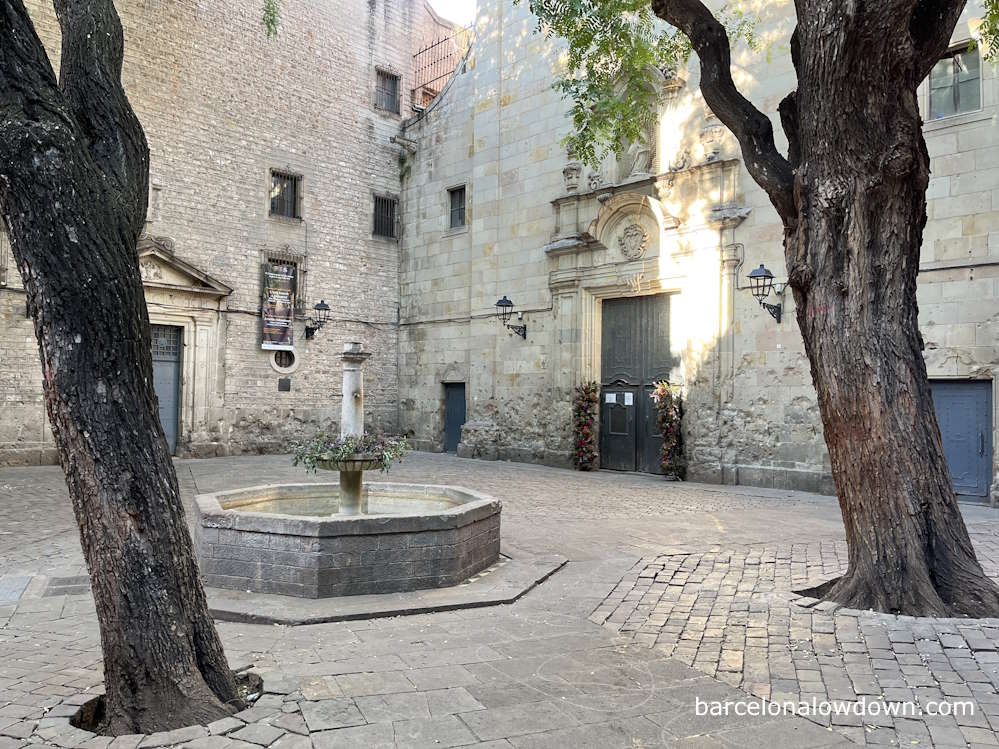
22. Plaça de Sant Felip Neri
After about a hundred metres, La Baixada de Santa Eulalia changes into Carrer de Sant Sever, and we turn left into Carrer de Sant Felip Neri, which leads us to the Plaça de Sant Felip Neri, one of the most picturesque squares in Barcelona.
The square takes its name from the church of Sant Felip Neri, a tiny Baroque-style catholic church dating back to the eighteenth century. The church’s pockmarked façade is a sombre reminder of the Spanish Civil War, when two bombs exploded in the square, killing 42 people, mostly children, who were sheltering inside the church.
23. Bishop’s Bridge
After taking a few photos, we continue along Carrer de Montjuïc del Bisbe past the church of Sant Sever to Carrer del Bisbe, which runs between Barcelona Cathedral and the Palau de la Generalitat.
Where the lanes meet, there’s a tiny plaza with a monument dedicated to five Barcelona residents who were executed during the Peninsula War, when French troops occupied Barcelona during the nineteenth century.
To our right, we get an excellent view of the Bishop’s Bridge, the small neo-gothic enhancement added during the Gothic Quarter’s facelift, which I mentioned earlier in this post. The buildings on either side of the bridge date back to the thirteenth and fourteenth centuries and are genuine Gothic.
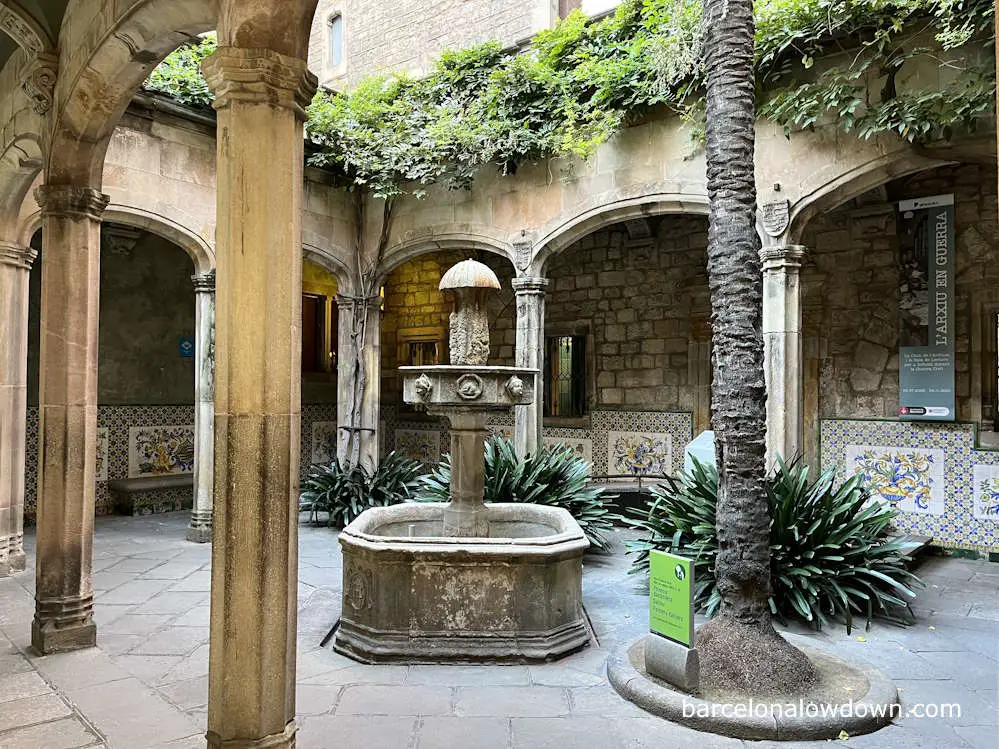
24. Casa de l’Ardiaca & Plaça Nova
From here, we continue northeast along Carre del Bisbe to Plaça Nova, the large square in front of Barcelona Cathedral.
Just before we enter the square, we come to the Casa de l’Ardiaca, which dates back to the twelfth century. This unusual Gothic building used to belong to Barcelona Cathedral but now houses the city archives and can be visited free of charge from 10 a.m. to 7:30 p.m.
Over the centuries, the building has been added to and remodelled several times, and it’s worth looking inside to check out the courtyard.
From here, we pass between two large stone towers, which are part of the Roman walls. Beside the towers, embedded in the walls of the Casa de l’Ardiaca, there’s a replica of a section of the Roman aqueduct which used to bring water to the city.
25. Barcelona Cathedral
Barcelona’s stunning Gothic cathedral, el Catedral de la Santa Creu i Santa Eulalia, dates back to the thirteenth century and was built on the site of an earlier Romanesque cathedral, which in turn replaced an earlier cathedral, believed to have been built during the fourth century.
Like most great European cathedrals, Barcelona Cathedral was built in several stages and took over a century to complete. Construction started in 1298, and the original façade and the cloisters were finished in 1448. As mentioned earlier, the ornate Neo-Gothic façade was added much later and completed in 1913.
Although it is possible to visit part of the nave free of charge by pretending that you are there to pray, I recommend you purchase a ticket which gives access to the rest of the Cathedral, including the crypt, the roof terraces, the choir and the cloisters.
There’s more information about visiting Barcelona Cathedral in this post.
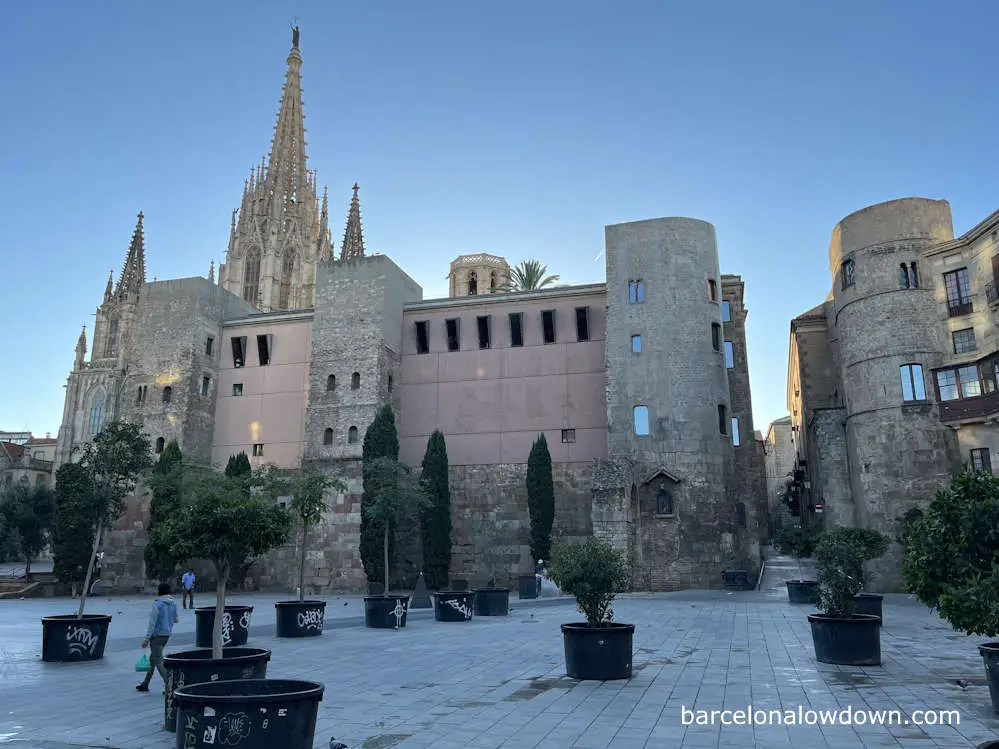
26. Plaça de Ramon Berenguer
After visiting the cathedral, we continue along Carrer de la Tapineria to Plaça de Berenguer el Gran, where we can see a section of Barcelona’s original Roman walls and an equestrian statue of Ramon Berenguer III, one of the counts who governed Barcelona during the middle ages.
The plaza is a few metres from the Jaume I metro station and marks the end of our self-guided walking tour of Barcelona’s Gothic Quarter.
Map of Barcelona’s Gothic Quarter
I’ve marked the places visited on the map below. When following the walking tour, I recommend you install the Wikiloc app on your phone and download the trail here.
Pl. de Ramon Berenguer el Gran, Barcelona, España
Pla de la Seu, s/n, Barcelona
Plaça Nova, 08002 Barcelona, España
Carrer del Bisbe, Barcelona
Pl. de Garriga i Bachs, Barcelona
Plaça de Sant Felip Neri, Barcelona
Baixada de Santa Eulàlia, Barcelona
Plaça de Sant Josep Oriol, Barcelona
Pl. de la Vila de Madrid, Barcelona
Carrer de Petritxol, Barcelona
Plaça del Pi, 7, Barcelona
Placeta de Manuel Ribé, 3, Barcelona
Carrer de Marlet, 5, Barcelona
Carrer de Ferran, 28, Barcelona
Plaça Reial, Barcelona
Carrer de n’Arai, 9999, Barcelona
Carrer de la Mercè, 1, Barcelona
Carrer Ample, 35, Barcelona
Plaça dels Traginers, Barcelona
Plaça de Sant Just, Barcelona
Plaça de Sant Jaume, 1, Barcelona
Carrer del Paradís, 10, Barcelona
Plaça del Rei, s/n, Barcelona
Pl. del Rei, s/n, Barcelona
Plaça de l’Àngel, Barcelona
Where to stay in the Gothic Quarter
The Gotic Quarter is a popular area and is conveniently located close to many of Barcelona’s top sights. There are plenty of hotels in the area to suit all budgets.
I recommend staying between the cathedral and Plaça de Catalunya. This area has several good-value hotels, including Hotel Barcelona Catedral, a comfortable, four-star hotel with a rooftop pool.
For more information about where to stay in Barcelona, check out my in-depth Barcelona neighbourhood guide.
Sightseeing passes and tickets
Most of the museums mentioned in this post are covered by the Barcelona Card, the official Barcelona sightseeing card issued by the Barcelona Tourist Office.
In addition to access to many of Barcelona’s top attractions and tours, the Barcelona Card also includes unlimited travel by public transport, including the airport metro.
By purchasing the Barcelona Card online from the official Tourist Office website, you can benefit from an extra 10% discount and can pick up your card at the airport on arrival.
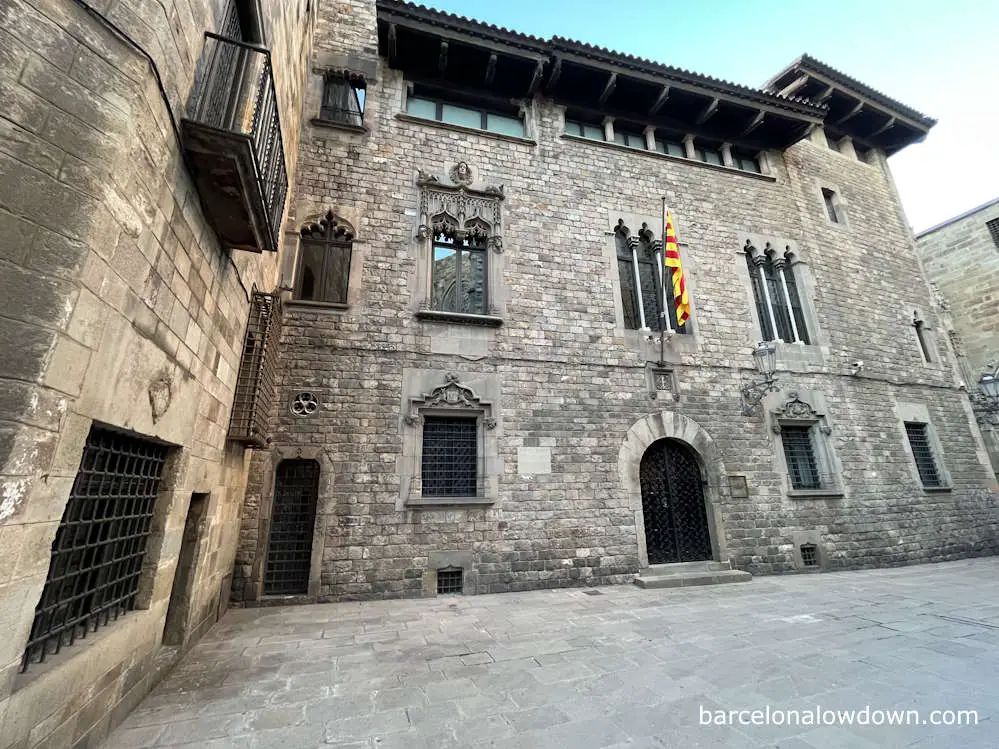
Tours of Barcelona’s Gothic Quarter
If you want to learn as much as possible about the history of the Gothic Quarter, I recommend you book one of the walking tours operated by the Barcelona Tourist Office.
The tours last two hours, and visit many of the sites mentioned in this post. The fully licensed guides speak fluent English, are well-versed in Barcelona’s history, and will be able to answer any questions you may have.
Barcelona Card holders get a 50% discount on the tour price. More information here >>
As always, if you’ve any questions or think I’ve missed anything, please leave a comment below and I’ll get back to you as soon as possible.

